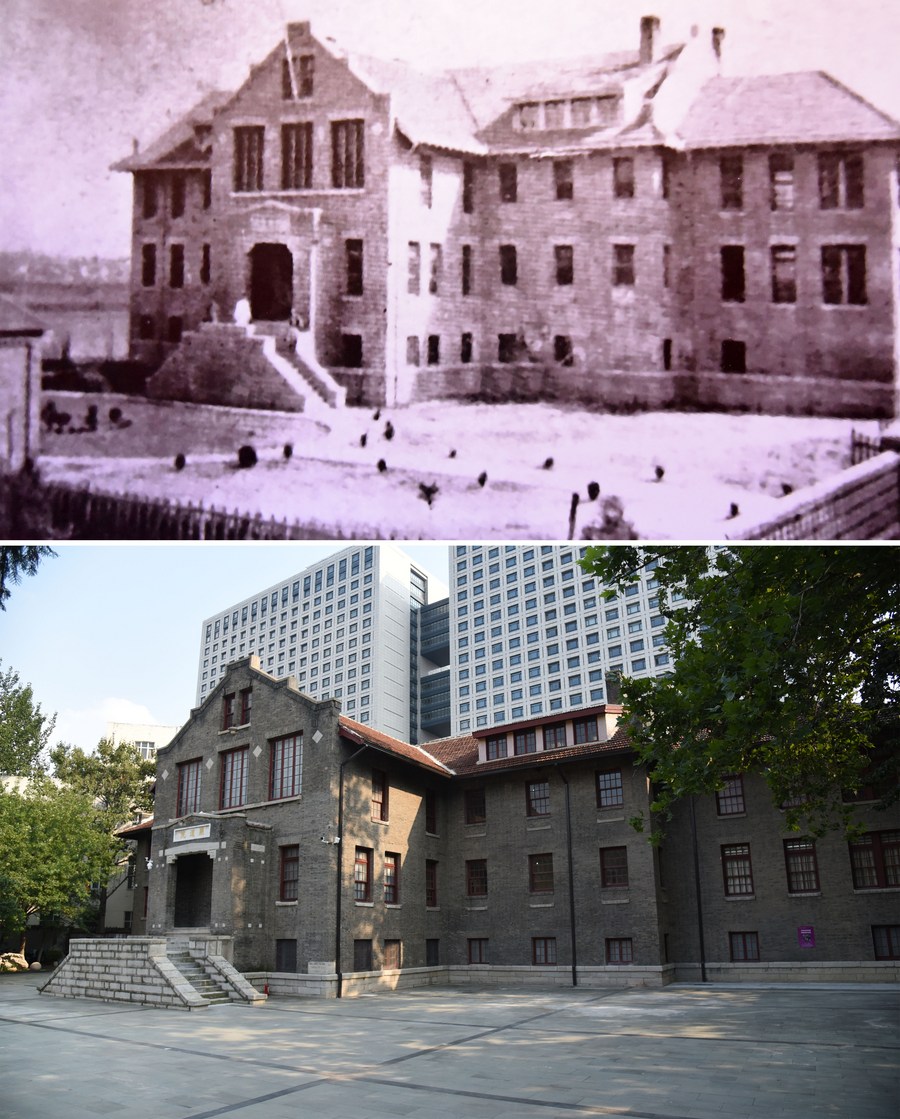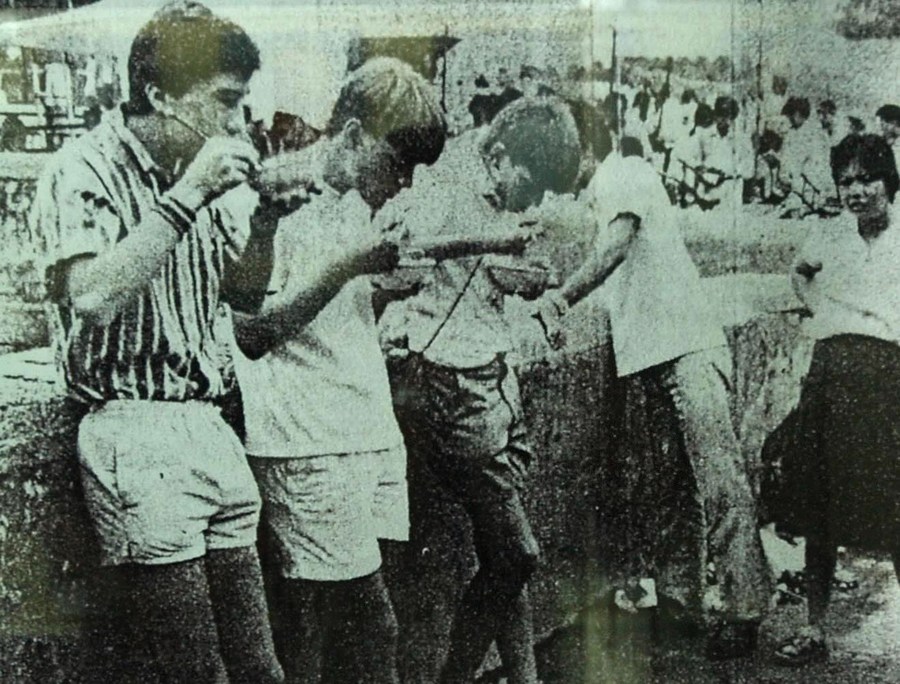-- A museum on the former site of a World War II concentration camp in east China opened to visitors on Thursday. The day marked the 75th anniversary of the victory of the Chinese People's War of Resistance against Japanese Aggression and the World Anti-Fascist War.
-- The Weihsien concentration camp, located in the city of Weifang, Shandong Province, was used by Japanese invaders from March 1942 to August 1945 to detain over 2,000 expatriates, including more than 300 children, from the United States, Britain, Canada and other countries.
-- Seven brick buildings have survived the vicissitudes of time at the site, and three of them were converted into the museum. The rest will be added to the museum in later phases.
JINAN, Sept. 4 (Xinhua) -- A museum on the former site of a World War II concentration camp in east China opened to visitors on Thursday.
The day marked the 75th anniversary of the victory of the Chinese People's War of Resistance against Japanese Aggression and the World Anti-Fascist War.
Speaking at a symposium commemorating the anniversary in Beijing, Chinese President Xi Jinping said the people of China, together with the rest of humanity, finally won a total victory against fascism through unbreakable will and a brave fight.
The victory belonged to the Chinese people, and also to all people across the world, he said, adding it will go down in the history of the Chinese nation as well as in the history of humanity's fight for justice.
The Weihsien concentration camp, located in the city of Weifang, Shandong Province, was used by Japanese invaders from March 1942 to August 1945 to detain over 2,000 expatriates, including more than 300 children, from the United States, Britain, Canada and other countries. Weihsien, also spelled as Weixian, is the former name of urban Weifang.
The museum exhibits kerosene lamps, kettles, clocks, and other items that were used by internees, as well as hand models from them and their descendants.
In 1882, Americans built a compound called "the Courtyard of the Happy Way," which was used as a church, hospital and school for decades. During WWII, the compound was converted by the Japanese into a concentration camp to incarcerate Westerners, who formerly lived in areas such as Beijing, Tianjin, Shandong and Henan.
The prison camp was liberated as a rescue team sent by the American troops in China parachuted to the site on Aug. 17, 1945, two days after the Japanese troops surrendered.

Combo photo shows a building of the compound of Ledaoyuan in 1925 (up) and the building on Aug. 18, 2020 (bottom, taken by Wang Kai) in east China's Shandong Province. (Xinhua)
The internees received help from local farmers, who secretly brought them food and aided some of them to escape.
"Heartfelt thanks to the Weihsien farmers who risked lives to smuggle food over the walls," Angela Elliot, a Canadian who was born in the camp in 1943, said in a video played at the opening ceremony of the museum.
Many former internees or their descendants, who cannot attend the museum's opening ceremony due to the COVID-19 pandemic, sent their congratulatory words and expressed appreciation to Chinese people by videos.
"The concentration camp is a testament to history, speaking about the Japanese aggression and persecution of citizens from Western countries," said Ji Shuchun, curator of the Weifang Museum who also serves as curator of the Weihsien concentration camp museum.

People celebrating the 60th anniversary of the liberation of the Weihsien concentration camp comfort each other in Weifang city of east China's Shandong Province, Aug. 17, 2005. (Xinhua/Xu Suhui)
PRISON CAMP
Stretching only 200 yards at its widest point and 150 yards long, the compound housed a few dormitory buildings in which each bed had a gap of just 18 inches. One's snore, belch, and the nightly tinkle of urine in the pot became the neighbor's music. For adults, the lack of privacy was the worst hell.
Such was the overcrowded "prison camp" described in an article by Mary Previte, who had been imprisoned as a child for three years. She was rescued in 1945 at the age of 12.
"Separated from our parents, we found ourselves crammed into a world of gut-wrenching hunger, guard dogs, bayonet drills, prisoner numbers and badges, daily roll calls, bed bugs, flies, and unspeakable sanitation," she said in a 2005 speech at the 60th-anniversary celebration of the liberation of the camp in Weifang.
Previte passed away last year after serving in the New Jersey General Assembly, focusing on juvenile justice and family issues.
The camp is also remembered as ordinary Chinese farmers had delivered food over the wall for prisoners at what was called "a black market."
Li Zhaoxian, 89, lives in a nearby community, which was a small village back then. He recalled that over seven decades ago grown-ups from the village would sneak to the outside of the site and exchange food and other necessities with internees.
Relevant documents showed the food rationed for the internees, mainly sorghum and corn, was limited and often rotten as the Japanese troops exhausted resources while expanding their invasion.

This undated file photo shows internees of the Weihsien concentration camp having lunch in east China's Shandong Province. (Xinhua)
Yan Bing, a guide with the Weifang Museum, said the filthy food had tortured the expatriates.
"Behind the guards' back, the expatriates would throw their belongings such as watches and jewelry outside the wall. When the nearby Chinese picked them up, they would bring white sugar, tomatoes, eggs and other food, forming a trading market over time," Yan said.
According to Yan, local villagers Zhang Xingtai and his son, both of whom were nightmen in the camp, had helped two of the internees escape from the camp.
REMEMBERING FOR PEACE
Over the years, original files and objects from the camp dwindled and the site itself was gradually shadowed by high-rises of Weifang.
Seven brick buildings have survived the vicissitudes of time at the site, and three of them were converted into the museum. The rest will be added to the museum in later phases.
A sculpture can be seen on the second floor of the museum: two rifles stuck in the ground, with a helmet hanging on the rifle stock and a peace dove standing on the helmet.
"The war is a common disaster for all humankind. The retrospection of war acts as a reminder to avoid wars. Wish the world a peaceful future," read the words on the wall behind the sculpture. ■
(Reporting by Yang Wen, Lyu Qiuping, Zhang Xinyi, Wang Huan)
(Video reporter: Wang Huan, Yang Wenshan; video editor: Liu Yuting)



